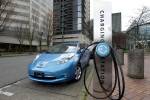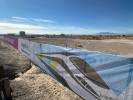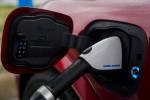Three-wheeled Aptera is striking, but concept is not entirely new
Apteryx -- A wingless bird native to New Zealand that runs along the ground on two legs.
Aptera 2e -- A wingless airplane native to California that zips along paved highways on three wheels.
Aptera company founder Steve Fambro and CEO Paul Wilbur have nurtured a new way to travel over land while gaining a ton of attention along the way.
The design of the company's flagship Aptera 2e is very aerodynamic. It was built like an airplane to slide through the air with very little resistance. The lift and lightness of the vehicle make the operator feel more like flying than driving a car. Aptera automotive engineers calculated that by emphasizing their low drag design; they could exceed 100 miles per hour by using just 23 horsepower from the vehicle's electric drive train system. The coefficient of drag is rated at 0.15, twice as efficient as most standard automobiles. At higher speeds beyond 55 mph, other passenger vehicles use more than half their horsepower just to push through the air. Horsepower requirements increase even more as vehicles approach 100 miles per hour.
When a driver releases the accelerator pedal on an Aptera, the vehicle will continue to slice through the air from the force of its momentum. Not only does this feature conserve battery pack energy, but the electric motor can become a generator while gliding. The rotating magnetic fields within the spinning motor can create electricity that can be fed back to the battery pack to help recharge it while coasting down a hill or coming to a stop. The company is developing a 300-volt lithium-ion battery pack that will sit under the floor of the vehicle, beneath the feet of the passengers, to instill a low center of gravity.
The two front wheels and steering system on the Aptera, coupled with one trailing wheel in back, comprise a "tadpole" design that makes the vehicle more stable at higher speeds, especially while turning. This three-wheel arrangement is in contrast to a standard "tricycle" design that uses one wheel in front to steer and two stationary wheels in back to drive the vehicle.
A 50-kilowatt AC electric motor propels the Aptera's front-wheel-drive system at a single speed without the need for a transmission. However there are three modes of driving that can be selected -- D1, D2 and D3. Selecting D3 provides quick acceleration in a high-speed mode. D1 provides a slower, more efficient mode to conserve range and battery pack energy. D2 is an in-between mode that handles midway between the speed and range extremes.
The Aptera 2e also has a built-in solar panel in the roof that can turn on an internal electric fan that automatically blows heat from the cabin to the outside air when moving or parked. The cabin cooling system design also helps prevent the electric motor and battery pack from overheating during operation. Gull wing doors open up and forward to allow easy access by driver and passenger into the cabin with accommodating overhead space.
The Aptera Web site shows that the company is anticipating using both hybrid and pure electric power trains. The hybrid version is projected to exceed 100 mpg with the gasoline engine and gas tank.
The Aptera 2-series vehicles will cost between $25,000 to $40,000, still a lot of money for a two-passenger sports car but much cheaper than a Tesla Roadster. The battery-powered version of the Aptera should be eligible for a $7,500 tax credit under the ARRA 2009 stimulus act, if purchased by the end of 2010. Aptera claims it will begin production and delivery in the final quarter of 2009 but only within a small Southern California service area. If it requires maintenance, the vehicle will need to be shipped back to Southern California locations until the company can expand its dealership sites across the country.
Although the Aptera design appears radical, electric versions of the "tadpole" three-wheel design have been around since the early part of the last century. A video movie recording from the 1920s shows a folding electric version. (Search "folding electric car from 1920s" on YouTube.com). It was marketed to people living in cities as a utility vehicle that could be pushed onto the street from a narrow apartment storage area and then unfolded with enough passenger space for the pair to ride to local shops. The design was modular and could be configured as either a convertible with side doors or with a fully enclosed top that included two doors on the front entrance of the vehicle. However, that 1920s design looked slow and would not pass the stringent safety requirements of today's automotive industry.
In 1999, the Corbin Motors "Sparrow" was introduced as a single-seat, three-wheel electric motorcycle that was embraced as a groundbreaking design concept. About 285 vehicles were produced during the company's short life. The Corbin Sparrow's 25-horsepower electric motor and drive train could zip up to freeway speeds of 75 mph but also had a limited range of about 30 miles when using its lead-acid DC battery pack. The innovative Corbin Sparrow also featured a unique aerodynamic design and construction. It was built on a monocoque chassis that was enclosed within a fiberglass top and automotive safety glass to make it lightweight but impact-resistant at higher speeds. Rigorous safety testing by the U.S. Department of Transportation was undertaken to qualify the Sparrow for distribution within the United States.
Aptera designers have also considered safety issues carefully. The Aptera 2-series vehicles provide air bags and seat belts as standard features. A composite silica fiber body is built around a honeycomb foam core, like an airplane wing. It is lightweight but also three times stronger than steel. Additional safety features include a supplemental 160-degree rear view camera and an LCD display screen built into the rear view mirror inside the cabin.
Stan Hanel has worked in the electronics industry for more than 30 years and is a long-time member of the Electric Auto Association and the Las Vegas Electric Vehicle Association. Hanel writes and edits for EAA's "Current Events" and LVEVA's "Watts Happening" newletters. Contact him at stanhanel@aol.com.
























